Makarov pistol
The Makarov pistol or PM (Russian: Пистолет Макарова, Pistolet Makarova, literally Makarov's Pistol) is a Soviet semi-automatic pistol. Under the project leadership of Nikolay Fyodorovich Makarov, it became the Soviet Union's standard military and police side arm in 1951.[6]
| Makarov pistol | |
|---|---|
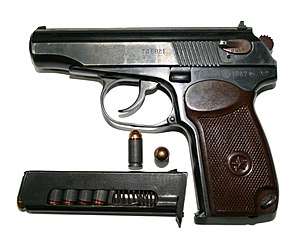 Soviet PM | |
| Type | Semi-automatic pistol |
| Place of origin | Soviet Union |
| Service history | |
| In service | 1951–present |
| Used by | See Users |
| Wars | First Indochina War Vietnam War Nicaraguan Revolution Lebanese Civil War Soviet invasion of Afghanistan South African Border War Angolan Civil War Tuareg rebellion (1990–1995) Burundian Civil War First Chechen War Second Chechen War[1] War in Afghanistan (2001–present)[2] Russo-Georgian War[3] Libyan Civil War Syrian Civil War War in Donbass Colombian Conflict |
| Production history | |
| Designer | Nikolay Makarov |
| Designed | 1948 |
| Manufacturer | Izhevsk Mechanical Plant (1949-2013) / Kalashnikov Concern (2013-present) (USSR/Russia), Ernst Thaelmann (Germany), Arsenal AD (Bulgaria), Norinco (China), Factory 626 (China) |
| Produced | 1949–present |
| No. built | 5,000,000[4]~10,000,000 [5] |
| Variants | See Variants |
| Specifications | |
| Mass | 730 g (26 oz) |
| Length | 161.5 mm (6.36 in) |
| Barrel length | 93.5 mm (3.68 in) |
| Width | 29.4 mm (1.16 in) |
| Cartridge |
|
| Action | Blowback |
| Muzzle velocity | 315 m/s (1,030 ft/s) |
| Effective firing range | 50 m (55 yd) |
| Feed system | 8-round detachable box magazine (10- and 12-round available on the PMM) |
| Sights | Blade front, notch rear (drift adjustable) |
Development
Shortly after the Second World War, the Soviet Union reactivated its plans to replace the Tokarev TT33 self-loading pistols and Nagant M1895 revolvers. The adoption of the future AK assault rifle relegated the pistol to a light, handy self-defence weapon. Therefore, the TT30/33 was unsuited for such a role, as it was heavy and bulky. Also, the Tokarev pistols omitted a safety and magazines were deemed too easy to lose. As a result, in December 1945, two separate contests for a new service pistol were created, respectively for a 7.62mm and 9mm pistol. It was later judged that the new 9.2×18mm cartridge, designed by B. V. Semin, was the best round suited for the intended role. The lower pressures of the cartridge allowed practical straight blowback operation (reducing the cost and complexity of the weapon), while retaining low recoil and good stopping power.
Several engineers took part in the contest, including Korovin, Baryshev, Vojvodin, Simonov, Rakov, Klimov, Lobanov, Sevryugin, and Makarov. Special emphasis was placed on safety, user-friendliness, accuracy, weight, and dimensions. After stringent handling, reliability, and other tests, Makarov's design, influenced by the German Walther PP,[7][8] stood out from the others through its sheer simplicity, excellent reliability, quick disassembly, and robustness. During April 1948, Makarov's pistol experienced 20 times fewer malfunctions than the competing Baryshev and Sevryugin counterparts, and had fewer parts. The pistol was therefore selected in 1949 for further development and optimization for mass production. Tooling was set up in the Izhevsk plant for production. After many major design changes and tweaks, the gun was formally adopted as the "9mm Pistolet Makarova", or "PM" in December 1951.
As the new standard issue sidearm of the USSR, the PM was issued to NCOs, police, special forces, and tank and air crews. It remained in wide front-line service with Soviet military and police until and beyond the end of the USSR in 1991. Variants of the pistol remain in production in Russia, China, and Bulgaria. In the U.S., surplus Soviet and East German military Makarovs are listed as eligible curio and relic items by the Bureau of Alcohol, Tobacco, Firearms and Explosives, because the countries of manufacture, the USSR and the GDR, no longer exist.[9]
In 2003, the Makarov PM was formally replaced by the PYa pistol in Russian service,[10] although as of 2016, large numbers of Makarov pistols are still in Russian military and police service.[11] The PM is still the service pistol of many Eastern European and former Soviet republics. North Korea and Vietnam also use PMs as standard-issue pistols.[12]
Although various pistols had been introduced in Russian service to replace the Makarov, none have been able to entirely supplant it; the MP-443 Grach/PYa is technically the Russian military’s standard sidearm but suffers from quality control and reliability issues. In September 2019, Rostec announced its Udav pistol went into mass production as the Makarov replacement. The Udav fires 9×21mm Gyurza rounds which are claimed to pierce 1.4 mm of titanium or 4 mm of steel at a 100 meters.[13][14][15][16]
Design
The PM is a medium-size, straight-blowback-action, all-steel construction, frame-fixed barrel handgun. In blowback designs, the only force holding the slide closed is that of the recoil spring; upon firing, the barrel and slide do not have to unlock, as do locked-breech-design pistols. Blowback designs are simple and more accurate than designs using a recoiling, tilting, or articulated barrel, but they are limited practically by the weight of the slide. The 9×18mm cartridge is a practical cartridge in blowback-operated pistols; producing a respectable level of energy from a gun of moderate weight and size. The PM is heavy for its size by modern US commercial handgun standards, largely because in a blowback pistol, the heavy slide provides greater inertia to delay opening of the breech until internal pressures have fallen to a safe level. Other, more powerful cartridges have been used in blowback pistol designs, but the Makarov is widely regarded as particularly well balanced in its design elements.[17]
The general layout and field-strip procedure of the Makarov pistol is similar to that of the PP.[17] However, designer N.Makarov and his team drastically simplified the construction of the pistol, improving reliability and reducing the part count to an astonishing 27, not including the magazine. This allowed considerable ease of manufacture and servicing. All of the individual parts of the PM have been optimised for mass production, robustness and interchangeability, partially thanks to captured German tooling, technology, and machinery.
The chrome-lined, four-groove, 9.27mm caliber barrel is pressed and pinned to the frame through a precision-machined ring. The 7 kg recoil spring wraps around and is guided by the barrel. The spring-loaded trigger guard is pivoted down and swung to either side on the frame, allowing removal of the slide. The front sight is integrally machined into the slide, and a 3–4 mm wide textured strip is engraved on top of the slide in order to prevent aim-disturbing glare. The rear sight is dovetailed into the slide and multiple heights are available to adjust the impact point. The extractor is of an external spring-loaded type, and features a prominent flange preventing loss if a case should rupture. The breech face is deeply recessed in order to aid in extraction and ejection reliability. The stamped sheet steel slide-lock lever has a tail serving the purpose of ejector. The one-piece, wraparound bakelite or plastic grip is reinforced with steel inserts and has a detent inside the screw bushing preventing unscrewing during firing. The sheet-metal mainspring housed inside the grip panel powers the hammer in both the main and rebound stroke, the trigger and the disconnector, while its lower end is the heel and spring of the magazine catch. The sear spring also serves another function, powering the slide lock lever. Makarov pistol parts seldom break with normal usage, and are easily serviced using few tools.[17]
The PM has a free-floating triangular firing pin, with no firing pin spring or firing pin block. This theoretically allows the possibility of accidental firing if the pistol is dropped on its muzzle. Designer Nikolay Makarov thought the firing pin of insufficient mass to constitute a major danger. The Makarov pistol is notable for the safety elements of its design, with a safety lever that simultaneously decocks and blocks the hammer from contacting the firing pin and returns the weapon to the long-trigger-pull mode of double action when that safety is engaged. When handled properly, the Makarov pistol has excellent security against accidental discharge caused by inadvertent pressure on the trigger, e.g., in carrying the weapon in dense brush or re-holstering it. However, the heavy trigger weight in double-action mode decreases first-shot accuracy. The Bulgarian-model Makarov pistol was approved for sale in the US state of California, having passed a state-mandated drop-safety test though the certification was not renewed and it has since been removed from the roster of approved handguns.[18]
Operation
The PM has a DA/SA trigger mechanism. Engaging the manual safety simultaneously decocks the hammer if cocked, and prevents movement of slide, trigger and hammer. Both carrying with safety engaged, or with safety disengaged and hammer uncocked are considered safe. The DA trigger pull is heavy, requiring a strong squeeze, trading first shot accuracy for safety. Racking the slide, manually cocking the hammer or firing a cartridge all cock the hammer, setting the trigger for the next shot to single action. The PM is a semi-automatic firearm, therefore its rate of fire depends on how rapidly the shooter squeezes the trigger. Spent cartridges are ejected some 5.5–6 meters away to the shooter's right and rear. After firing the last round, the slide is held back by the slide stop lever/ejector. Magazines can be removed from the gun via the heel release, located on the bottom of the grip. After loading a fresh magazine, the slide can be released by pressing the lever on the left side of the frame or by racking the slide and releasing it; either action loads a cartridge into the chamber and readies the pistol to fire again.
Variants
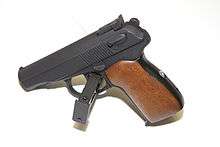
The Makarov pistol was manufactured in several communist countries during the Cold War and afterwards; apart from the USSR itself, they were East Germany, Bulgaria, China, and post-reunification Germany, which also found itself with several thousand ex-GDR Makarov pistols.
The most widely known variant, the PMM (Pistolet Makarova Modernizirovannyy or Modernised Makarov pistol), was a redesign of the original gun. In 1990, a group of engineers reworked the original design, primarily by increasing the load for the cartridge. The result is a significant increase in muzzle velocity and generation of 25% more gas pressure. The PMM magazine holds 12 rounds, compared to the PM's eight rounds. Versions that held ten rounds were produced in greater quantities than the 12-round magazine. The PMM is able to use existing 9.2×18mm PM cartridges and has other minor modifications such as more ergonomic grip panels as well as flutes in the chamber that aid in extraction.[19] As of 2015, it is—alongside MP-443 Grach—the service pistol of the Russian Airborne Troops.[20]
A silenced version of the Makarov pistol, the PB, was developed for use by reconnaissance groups and the KGB, with a dedicated detachable suppressor.
An experimental variant of the Makarov pistol, the TKB-023, was designed with a polymer frame to reduce the weight and costs of the weapon. It had passed Soviet military trials but was never fielded, due to concerns about the polymer's capacities for long-term storage and use.
Poland, Hungary, and Czechoslovakia have developed their own handgun designs chambering the 9×18mm round. Hungary developed the FEG PA-63, Poland the P-64 and the P-83 Wanad and Czechoslovakia the vz.82. While similar in operation (straight blowback), and chambered for the same round, these pistols are often found labeled at gun shows by some US gun retailers as "Polish Makarovs" and "Hungarian Makarovs". Nonetheless, these cosmetically similar designs are independent of the PM and have more in common with the Walther PP (which, in fact, was also a major influence on the original Russian Makarov[21]).
A wide variety of aftermarket additions and replacements exist for the Makarov pistol, including replacement barrels, custom grips, custom finishes and larger sights with various properties to replace the notoriously small originals. A scope/light mount exists for the Makarov pistol but requires a threaded replacement barrel.
Baikal
Baikal is a brand developed by IGP around which a series of shotgun products were designed from 1962. After the collapse of the USSR, commercial gun manufacture was greatly expanded under the Baikal brand.
During the 1990s, Baikal marketed various Makarov-derived handguns in the United States under the IJ-70 model. Included were handguns in both standard and high-capacity frames. They were available in .380 ACP in addition to the standard 9 mm Makarov round. Some minor modifications were made to facilitate importation into the United States, including the replacement of the rear fixed sight with an adjustable sight (only these Russian models marketed abroad feature an adjustable sight). A sporting version is the Baikal-442.[22] The importation of these commercial models into the U.S. was later further restricted with the U.S. Government's importation ban on Russian firearms.
The Baikal IZH-79-8 is a modified version of the standard Makarov pistol, with an 8 mm barrel, modified to allow it to fire gas cartridges. These guns proved popular after the fall of the USSR, and were used in Eastern Europe for personal protection. However, unlike most gas firing guns, the body is made of standard Makarov-specification steel.
Users
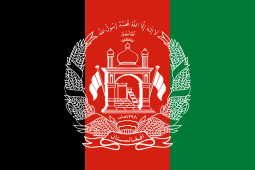


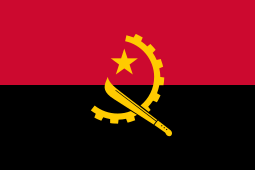








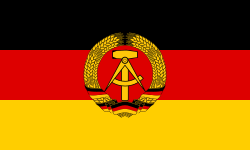



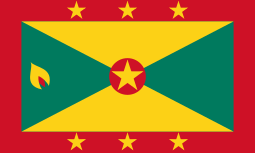




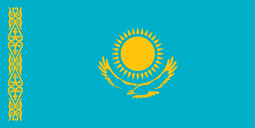
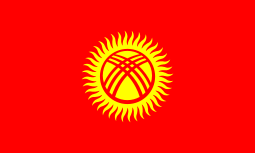
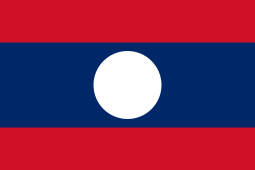

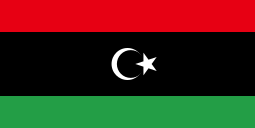






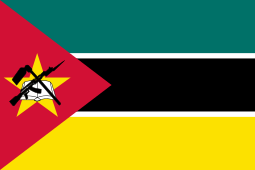

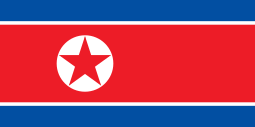







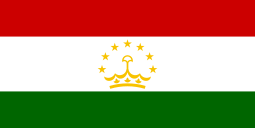
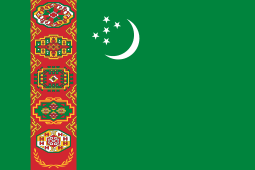



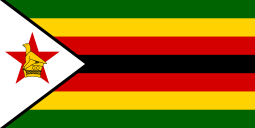
See also
- 9×18mm Makarov
- Izhevsk Mechanical Plant
- Makarych
- MP-448 Skyph
- List of Russian weaponry
References
- Galeotti 2017, p. 32.
- Small Arms Survey (2012). "Surveying the Battlefield: Illicit Arms In Afghanistan, Iraq, and Somalia". Small Arms Survey 2012: Moving Targets. Cambridge University Press. p. 332. ISBN 978-0-521-19714-4. Archived from the original (PDF) on 2018-08-31. Retrieved 2018-08-30.
- Galeotti 2017, p. 22.
- "New Publication: The Makarov Pistol (Volume 1): Soviet Union and East Germany by Henry C. Brown and Cameron S. White".
- "Nikolay Makarov - Russiapedia Science and technology Prominent Russians".
- Makarov.com, Makarov Basics, archived from the original on 2008-02-23, retrieved 2008-01-27
- Dowling, Timothy C. (2015). Russia at War. ABC CLIO. p. 496. ISBN 978-1-59884-947-9.
- Sweeney, Patrick (2009). Gunsmithing - Pistols and Revolvers. GunDigest Books. p. 355. ISBN 978-1-4402-0389-3.
- Peterson, Philip (23 June 2011). "How Did They Get Here?". Standard Catalog of Military Firearms: The Collector's Price and Reference Guide. Iola, Wisconsin: F+W Media. p. 13. ISBN 978-1-4402-2881-0. Retrieved 10 July 2013.
- world.guns.ru, Modern Firearms - Makarov PM, archived from the original on 2008-04-05, retrieved 2008-01-27
- Galeotti, Mark (February 2017). The Modern Russian Army 1992–2016. Elite 217. Osprey Publishing. pp. 55–56. ISBN 9781472819086.CS1 maint: ref=harv (link)
- Hogg, Ian; Walter, John (29 August 2004). Pistols of the World. David & Charles. p. 180. ISBN 978-0-87349-460-1. Archived from the original on 27 June 2014. Retrieved 10 July 2013.
- Here’s an update on the Russian handgun that will likely replace the Makarov Archived 2019-01-18 at the Wayback Machine. Military Times.com/Gear Scout. 8 January 2019.
- Russia to replace legendary Makarov with new pistol Archived 2019-01-18 at the Wayback Machine. France 24. 18 January 2019.
- https://news.ru/en/weapon/russian-new-udav-pistol-passes-military-test/
- http://www.armstrade.org/includes/periodics/news/2019/0912/104554390/detail.shtml
- Kinard, Jeff (2004). Pistols: An Illustrated History of Their Impact. ABC-CLIO. pp. 257, 259–260. ISBN 978-1-85109-470-7. Archived from the original on 8 May 2016. Retrieved 10 July 2013.
- "Department of Justice Bureau of Firearms De-Certified Handgun Models" (PDF). ca.gov. Department of Justice Bureau of Firearms. Archived (PDF) from the original on 13 January 2017. Retrieved 10 January 2017.
- Cutshaw, Charles Q. (28 February 2011). Tactical Small Arms of the 21st Century: A Complete Guide to Small Arms From Around the World. Iola, Wisconsin: Gun Digest Books. p. 105. ISBN 978-1-4402-2709-7. Archived from the original on 3 June 2016. Retrieved 10 July 2013.
- "ВДВ: основной снайперской винтовкой десантных войск России стала СВ-98". August 2015. Archived from the original on 2015-08-04. Retrieved 2015-08-11.
- world.guns.ru Archived 2013-06-18 at the Wayback Machine Quote: "almost immediately after the war the GAU issued a new set of requirements for a military and police pistol. These requirements asked for a compact, double action pistol of the Walther PP type...". Retrieved 27 April 2013.
- ' "BAIKAL-442" Sporting Pistol (for export)' Archived 2009-08-31 at the Wayback Machine
- Jones, Richard D. Jane's Infantry Weapons 2009/2010. Jane's Information Group; 35 edition (January 27, 2009). ISBN 978-0-7106-2869-5.
- Albania: Special Operations and Counterterrorist Forces Archived 2013-08-22 at the Wayback Machine at specialoperations.com (a non-official, personal website). Retrieved 8 September 2012.
- "World Infantry Weapons: Algeria". 2015. Archived from the original on 24 November 2016. Retrieved 22 May 2019.
- Small Arms Survey (2007). "Armed Violence in Burundi: Conflict and Post-Conflict Bujumbura" (PDF). The Small Arms Survey 2007: Guns and the City. Cambridge University Press. p. 204. ISBN 978-0-521-88039-8. Archived from the original on 2018-08-27. Retrieved 2018-08-29.
- Kokalis, Peter. Weapons Tests And Evaluations: The Best Of Soldier Of Fortune. Paladin Press. 2001. pp99–102.
- Jenzen-Jones, N.R.; Ferguson, Jonathan (2014). Raising Red Flags: An Examination of Arms & Munitions in the Ongoing Conflict in Ukraine (PDF). Armament Research Services Pty. Ltd. p. 37. ISBN 9780992462437.
- https://www.americanrifleman.org/articles/2015/7/24/east-german-makarov-a-cold-war-classic
- Hogg, Ian (2002). Jane's Guns Recognition Guide. Jane's Information Group. ISBN 0-00-712760-X.
- "Urgent Fury 1983: WWII weapons encountered". wordpress.com. 18 October 2015. Archived from the original on 12 June 2018. Retrieved 22 March 2018.
- Air Marshal Raghunath Nambiar (2019-07-25). "How I Bombed Tiger Hill From A Mirage 2000". Retrieved 2019-07-31.
- https://silahreport.com/2019/08/10/podcast-vol-4-libyan-assembled-makarovs-yemeni-colloquial-names/
- Small Arms Survey (2005). "Sourcing the Tools of War: Small Arms Supplies to Conflict Zones" (PDF). Small Arms Survey 2005: Weapons at War. Oxford University Press. p. 166. ISBN 978-0-19-928085-8. Archived from the original on 2018-08-30. Retrieved 2018-08-29.
- US Department of Defense: North Korea Country Handbook (1997) Archived 2016-03-04 at the Wayback Machine page xii, at Federation of American Scientists. Retrieved 8 September 2012.
- "World Infantry Weapons: Sierra Leone". 2013. Archived from the original on 24 November 2016.
- "Archived copy" (PDF). Archived from the original (PDF) on 2015-06-20. Retrieved 2015-06-20.CS1 maint: archived copy as title (link)
- Marchington, James (2004). The Encyclopedia of Handheld Weapons. Lewis International, Inc. ISBN 1-930983-14-X.
- VCCorp.vnwebsite=soha.vn. "Quân đội Nhân dân Việt Nam được trang bị những loại súng ngắn nào". Archived from the original on 23 March 2018. Retrieved 22 March 2018.
- "[Indo Defense 2018] Vietnamese Small Arms Part Two: Grenade Launcher's, Galil ACE's, and OSV-96's -". 2018-11-30. Archived from the original on 2018-12-01. Retrieved 2018-12-01.
Bibliography
- Datig, Fred A. (1988). The History and Development of Imperial and Soviet Russian Military Small Arms and Ammunition 1700–1986. Glenview, IL: Handgun Press. ISBN 9780945828037. OCLC 19742826.
- Kokalis, Peter (2001). Weapons Tests and Evaluations: The Best of Soldier of Fortune. Boulder, Col.: Paladin Press. pp. 99–102. ISBN 978-1-58160-122-0. OCLC 49695650.
External links
| Wikimedia Commons has media related to: |